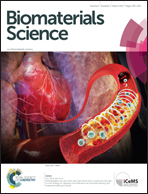Biocompatible CuS-based nanoplatforms for efficient photothermal therapy and chemotherapy in vivo
Abstract
Near-infrared (NIR) photothermal therapy (PTT) is a new approach to ablate cancer without affecting normal tissues. A pivotal concern of PPT is to develop photo-responsive agents with high biocompatibility as well as effective photothermal conversion efficiency. Copper sulfide (CuS) nanoparticles prepared are characterized by their low synthesis cost, wide NIR absorption range, good biocompatibility and favorable NIR photothermal conversion efficiency. CuS nanoparticles were then coated with mesoporous silicon dioxide (SiO2) by the Stober method, and further loaded with anticancer drug doxorubicin (DOX). The nanocomposites obtained were named CuS@MSN-DOX. The infrared thermal imaging of CuS@MSN-DOX demonstrated its favorable photothermal efficacy. The potential of CuS@MSN-DOX utilized as a multifunctional platform for combined PPT and chemotherapy was exploited both at the cell level and in a mice model. The result demonstrated that CuS@MSN-DOX was endowed with the synergistic effect of chemo-photothermal therapy, which confirmed that it is a promising candidate for combined therapy of cancer.

- This article is part of the themed collection: Celebrating Excellence in Research: 100 Women of Chemistry


 Please wait while we load your content...
Please wait while we load your content...